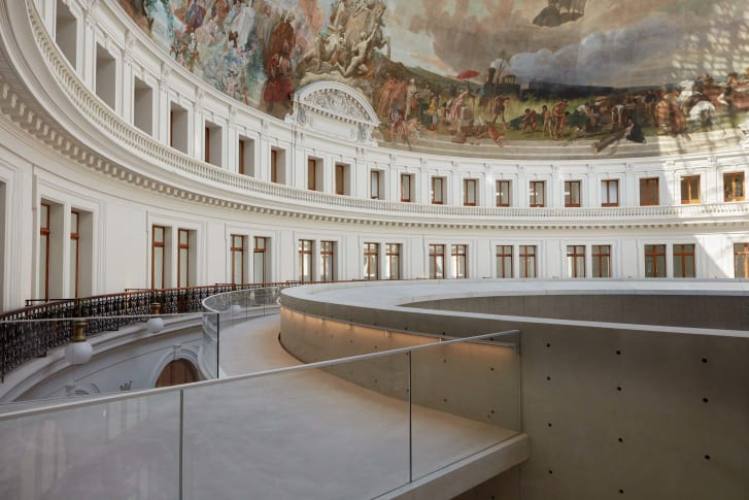
Bourse de Commerce. COURTESY
Paris' former stock exchange, the Bourse de Commerce, will reopen its doors this week having undergone a $195 million transformation into a new landmark museum for contemporary art.
Three years in the making, the redesign was led by Japanese architect Tadao Ando and supported by a team of Parisian architects, including NeM Architects Agency. The expansive space, stretching over 10,000 square meters (more than 100,000 square feet), will house the contemporary art collection of French billionaire François Pinault.
Pinault, who is the founder of luxury conglomerate Kering (parent company of fashion houses Gucci and Saint Laurent, among others), has spent 20 years working toward opening a private museum in Paris for his collection. “It began as a dream, a dream that seemed out of reach. Then this dream became an ambition,” he said in a press statement.
“Today, that ambition has become reality. For years, I have longed to be able to show my collection in Paris, the city I love.”
The museum's inaugural exhibition, titled “Ouverture,” (in reference to the introductory symphonic piece sung at the beginning of an opera) will present works by a number of international artists, including Kerry James Marshall, Marlene Dumas, Luc Tuymans and Cindy Sherman.
Pinault described the debut as a “manifesto of the values” he has long championed, namely, “the thirst for freedom, the rebuttal of injustice, the acceptance of diversity.”
Situated walking distance from the Louvre, the protected building dates back to the 18th century and has undergone a number of renovations over the years. Its original circular shape was established in 1767, when it became a grains exchange for the city, a hub for the storage and sale of wheat.
Ando has added a central concrete cylinder to the inside of the museum, beneath the building's signature cupola, as “a hyphen to link the past and the present, to produce a vision of the future,” he said.
The entire project has been “built on the idea of setting dialogues between the present of contemporary creation and the past,” said Martin Bethenod, deputy chief executive officer of the Pinault Collection.
Harmony between heritage and modernity is built into every inch of the Bourse de Commerce's redesign, right through to the museum cafe. Even the menu of the eatery -- called the Halle aux Grains -- will pay homage to the building's past life, featuring modest ingredients like cereals, grains, seeds and pulses.
The Bourse de commerce (Commodities Exchange) is a building in Paris, France, originally used as a place to negotiate the trade of grain and other commodities, now used to provide services to businesses by the Paris Chamber of Commerce. It has its origins in a circular corn exchange built in 1763–67, with an open-air interior court that was capped by an iron dome in 1811. In a major reconstruction in 1888–89 much of the structure was replaced, although the layout remained the same and the dome was retained with modifications. The dome of the building is listed as a historical monument.
Between 1574 and 1584 Jean Bullant (1515–78) built a hôtel particulier (grand house) on the site for Catherine de' Medici (1519–89). A tower with an encaged observation platform, now called the Medici column, was built beside the hôtel from which observations of the stars could be made for astrological purposes. The Queen's hôtel was bought by Charles de Bourbon-Condé, Count of Soissons, who repaired and enlarged it. The hotel became called the Hôtel de Soissons. The indebted last owner was Victor Amadeus of Savoy (1690–1741). After his death the hotel was demolished in 1748 and the materials sold to pay the creditors. The city of Paris bought the column from its first owner, Laurent Destouches, which saved it from destruction.
Between 1763 and 1767 the City of Paris built a circular building on the site for the storage and sale of wheat. The Halle aux blés (Corn Exchange) was designed by Nicolas Le Camus de Mézières with a circular central courtyard and a double staircase. The layout of that building has been retained. From 1782 to 1783 a wooden dome was built to a design by Jacques-Guillaume Legrand and Jacques Molinos based on the principles defined by Philibert de l'Orme. On 16 October 1802 the cupola was destroyed by fire. A new design by François-Joseph Bélanger for an iron dome covered in sheets of copper was selected after some controversy. Victor Hugo described the dome in his 1831 novel Notre-Dame de Paris as an English jockey-cap on a large scale. The corn exchange was closed in 1873. In 1885 the building was assigned to the Commodities Exchange. Until then the exchange had been housed in the Palais Brongniart.
In 2016, the mayor of Paris, Anne Hidalgo, offered François Pinault a 50-year lease on the Bourse de Commerce for a lump sum of €15 million, plus yearly fees. Shortly after, the Paris City Council approved the project to transform the building into an exhibition space for contemporary art, including pieces from his private collection of more than 3,500 works valued at around €1.25 billion. In 2017, Pinault publicly presented plans by architect Tadao Ando for placing a 30-foot-high concrete cylinder inside the building to be the Bourse’s main exhibition gallery, at construction costs of $170 million. Spanning more than 113,000 sq ft (10,500 m2), it is expected to be the biggest of the three museums operated by Pinault. It will have 32,000 sq ft (3,000 m2) of exhibition space and an underground auditorium.






0 Comments